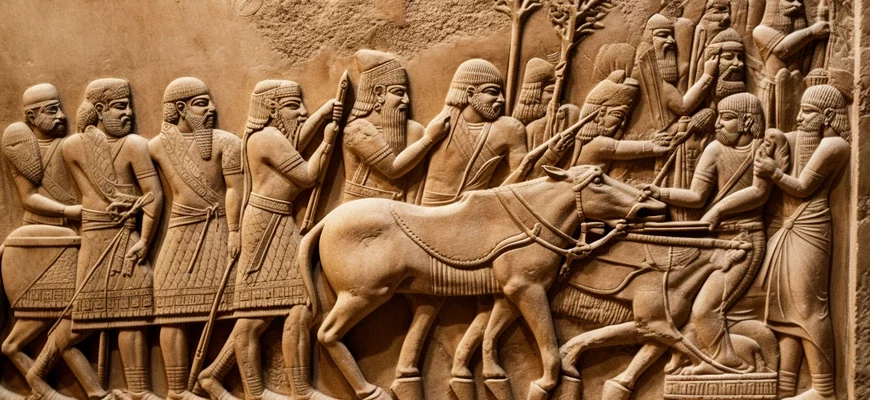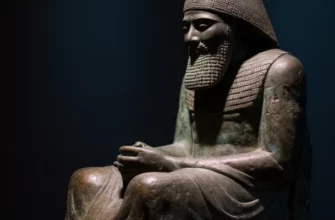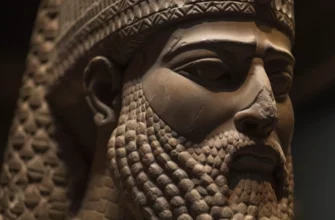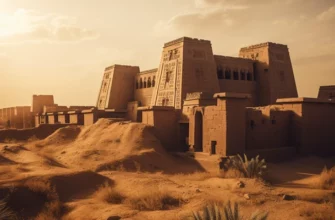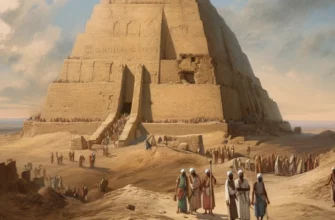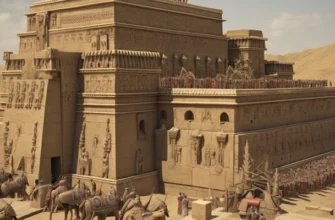The Sumerian economy and agriculture developed more than 4,000 years ago in what is now Iraq. The Sumerians developed agriculture, the production of goods from clay, metal, and fabrics, as well as trade with other civilizations. To improve trade, the Sumerians invented a system of weights and measures. Money also appeared in Sumer as a means of exchange and storage of wealth. The development of the Sumerian economy and agriculture had a great impact on the development of human history.
- Agriculture
- Development of agriculture
- Growing various crops
- Tools and technologies for working the land
- Industry
- Production of goods from clay, metal, and fabrics
- Sumerian crafts and skills
- Trade
- System of weights and measures
- Money
- The emergence of money
- The use of different types of money
- Functions of money
- Conclusion
Agriculture
Agriculture was an important part of the economy of the Sumerian civilization, which developed in Iraq more than 4,000 years ago. The Sumerians studied nature and developed methods of cultivating the land, which allowed them to grow various crops, including wheat, barley, apples, grapes, as well as oilseeds and flax. Hand and animal plows were used to cultivate the land, as well as other tools such as scythes and sickles. Important factors in the development of Sumerian agriculture were the Euphrates and Tigris rivers, which provided sufficient water for irrigation. Agriculture ensured food security for the population and was an important factor in the development of Sumerian civilization.
Development of agriculture
The development of agriculture was one of the important components of the Sumerian civilization’s economy. They studied the soil and developed new methods of tilling the land using plows, scythes, and other tools. The Sumerians grew various crops, including wheat, barley, apples, grapes, oilseed, and flax. An important factor in the development of agriculture was the Euphrates and Tigris rivers, which provided sufficient water for irrigation. The development of agriculture allowed the Sumerians to provide themselves with food and become known for their ability to develop technology and the economy.
Growing various crops
The Sumerians were known for their advanced agriculture and grew various crops. The most common crops were wheat and barley, which were used to make bread. The Sumerians also grew fruits such as apples, pears, and grapes, which were used to make wine and other beverages. One important crop was oilseed, which was used to produce oil for cooking and lamps. The Sumerians also grew flax, which was used to make textiles and oil. The variety of crops grown by the Sumerians is evidence of their high level of agricultural and economic development.
Tools and technologies for working the land
The Sumerians were innovative rural craftsmen and developers of tools for working the land. One of the most important tools was the plow, which was used to till the soil before sowing. They also used scythes to harvest various crops, including grains. Another important tool was the axe, which was used for cutting trees and other heavy work. In addition, the Sumerians developed irrigation technologies using canals and irrigation systems, which ensured moisture for plants throughout the growing season. As a result of the development of tools and technologies, the Sumerians were able to increase the productivity and yield of their crops and ensure the stability of their economy.
Industry
The Sumerians are known for their developed industry, which allowed them to become one of the first civilizations in human history. The main industries were metalworking, ceramics, textiles, and wine production. The Sumerians knew how to use copper and bronze to make tools, weapons, and household items. They also made ceramic vessels, statuettes, and other items that reflected their culture and religion. Textile production, particularly silk and linen, was also an important industry. The most famous export of the Sumerians was wine, which they produced from grapes. The development of industry allowed the Sumerians to achieve a high standard of living and realize their potential in various fields.
Production of goods from clay, metal, and fabrics
The Sumerians are known for their skill in producing goods from clay, metal, and fabric. They used clay to create various ceramic products, such as dishes, vases, figurines, and other items. The Sumerians also produced metal tools and weapons from copper and bronze, including knives, axes, and plow beds.
The textile industry was also an important sector for the Sumerians, who made various textile products from linen and cotton, including clothing, towels, and other items.
All these industries allowed the Sumerians to develop trade and create empires that traded their products with other civilizations. The production of goods from clay, metal, and fabrics was an important factor in the development of Sumerian culture and economy.
Sumerian crafts and skills
The Sumerians developed a variety of crafts and skills that played an important role in their lives. Among them were blacksmithing, ceramics, jewelry making, weaving, pottery, stoneworking, and others.
Blacksmithing was necessary for the production of tools, weapons, and other metal products. Ceramics and pottery were developed through working with clay and making dishes, vases, figurines, and other items. Jewelry making allowed for the production of jewelry from gold, silver, and other materials.
Weaving and the textile industry were highly developed among the Sumerians, allowing them to produce various textile products, including clothing, towels, and other items. Stoneworking was important for the production of building materials and various stone products, such as statuettes, images of gods, and others.
The Sumerians had many different crafts and skills that contributed to the development of their culture and economy. They became an important element in the formation of the craft industry, which has advanced to the present day.
Trade
Trade was an important part of the Sumerian economy. They were located at the crossroads of trade routes, which allowed them to trade with many peoples of that time.
The Sumerians traded with the Aegean islands, Syria, Egypt, and other countries. The main goods they exported were grain, fish, honey, textiles, blankets, and other goods. The Sumerians had a developed network of markets on their territory, where they traded not only goods but also services.
Trade contributed to the development of the Sumerian economy and brought them wealth. It also promoted cultural exchange and interaction between different peoples, which contributed to the formation of world history.
System of weights and measures
The Sumerians developed a system of weights and measures that was advanced for its time. They used cubic measures for volume, which made it easy to compare different volumes. For example, mustard seeds were measured in “gur,” which was approximately 3.3 liters.
As for weight, the Sumerians used two systems: the shat and the min. A shat consisted of 60 grams, and a min was 1/60 of a shat, or 1 gram. Thus, the Sumerian system of weights and measures was very convenient and accurate, allowing them to trade and distribute goods.
This system of weights and measures was widespread in many territories that traded with the Sumerians and became the prototype for the further developed system of measurement in human history.
Money
The Sumerians were one of the first civilizations to use money as a medium of exchange. The first coins in the form of silver discs appeared in Sumer around 2500 BC. These coins had various symbols and images stamped on them and were used to exchange goods.
Throughout Sumerian history, money evolved from coins to paper banknotes. The Sumerians also used many other forms of exchange, such as grain, livestock, fabrics, and metals.
Sumerian money had no standards and was made by different craftsmen, which led to different shapes and sizes of money. Nevertheless, despite this, Sumerian money is an important discovery in the development of the monetary system, which had a significant impact on the development of trade and the economy in subsequent centuries.
The emergence of money
The emergence of Sumerian money is associated with the development of trade and economic growth in this civilization. The Sumerians used various forms of exchange, such as livestock, grain, metals, and other goods. However, these forms of exchange had their limitations, such as the difficulty of transportation and storage.
As a result, the Sumerians began to use silver discs as a means of exchange, which had a specific weight and size. These discs became the first coins in history and were used for buying, selling, and other types of exchange. In turn, the growth in the use of coins led to the development of a monetary system in Sumer and other civilizations that followed their example.
The use of different types of money
The Sumerians used different types of money in their economy, depending on their purpose and role. One type of money was silver discs, which were used for buying and selling and other types of exchange. The Sumerians also used grain as a medium of exchange, especially in the early stages of their development.
In addition, various metal products, such as gold, copper, and bronze, were used in Sumer, which had their own value and were used for exchange. The most developed cities of Sumer, such as Ur and Nippur, had their own mints, where coins were made from various metals, such as gold, silver, and copper.
Credit money was also used in Sumer, which was issued to merchants and craftsmen to carry out transactions involving the exchange of goods. Credit money had different circulation times and different repayment terms, depending on the agreement between the parties.
Functions of money
Money in Sumer performed several functions, including:
Means of exchange – money was used to carry out purchase and sale transactions and other types of exchange of goods and services.
A store of value – owning money allowed the value of goods or services to be preserved for the future.
A measure of value – money was used to assess the value of goods and services, which was important for trade and exchange.
A means of payment – money was used as a means of payment for goods and services, which ensured efficient and convenient trade.
A means of settling debts – money was used to repay debts and settle accounts between different individuals and organizations.
These functions of money were very important for the economic development of Sumer, as they enabled trade and other transactions that contributed to economic development.
Conclusion
Agriculture and economics were key factors in the development of Sumerian civilization. The Sumerians were the first to develop an effective agricultural system and establish the first cities. They were also known for their industrial and craftsmanship skills, which allowed them to create quality goods and provide for their needs. The system of weights and measures, as well as the use of money, enabled effective trade and relations between different cities and countries.
All these factors allowed the Sumerians to develop their civilization and create a complex social and political structure. They were pioneers in many fields that influenced the development of world history, such as architecture, art, science, and culture. The Sumerians left a significant mark on world history, and their achievements in agriculture and economics inspire our research and development today.
